Archive for the ‘Wildlife A-Z’
-
Travelling The Distance – Seasonal Migration
Posted in Wildlife A-Z | September 28, 2010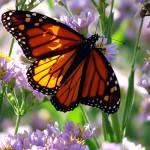 Well, look around you, and you’ll notice it’s that time of the year when the leaves are going to fall off the trees and the days are going to grow shorter and the weather will only get cooler from here. Animals all over the world will also fall into their set of seasonal migrations. Well, and unlike what you may have wrongly believed, there are more than just the birds who make the journey. There are a number of mammals and insects that are known to migrate during this time. Here we take you along the path of a few of the biggest or the farthest travelling, oddest of the lot, movers and shakers when it comes to the animal kingdom. The Monarch of Beautiful Masses, Monarch Butterflies: The Monarch butterflies that live east of the Rocky Mountains [...]
Well, look around you, and you’ll notice it’s that time of the year when the leaves are going to fall off the trees and the days are going to grow shorter and the weather will only get cooler from here. Animals all over the world will also fall into their set of seasonal migrations. Well, and unlike what you may have wrongly believed, there are more than just the birds who make the journey. There are a number of mammals and insects that are known to migrate during this time. Here we take you along the path of a few of the biggest or the farthest travelling, oddest of the lot, movers and shakers when it comes to the animal kingdom. The Monarch of Beautiful Masses, Monarch Butterflies: The Monarch butterflies that live east of the Rocky Mountains [...] -
The Truth About Anacondas
Posted in Wildlife A-Z | September 21, 2010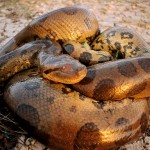 Snakes are perhaps one of the most feared creatures on earth. They’re long and they’re legless, they’re fast and they’re flexible, they are known to strike fear into the deepest spot of the hearts of people who are not accustomed to their presence. Just like other reptiles, they’re covered with scales, but unlike their lizard/crocodile cousins, the snake has skin that is far thinner. The largest snakes on planet earth are said to be the giant anaconda and the reticulated python; both of these are known to grow to size of about 33 feet in some cases and could weigh up to about 550 pounds. They may not be poisonous, but the truth is that they could easily crush you. The Anaconda: The anaconda is part of the boa family and is a constrictor. [...]
Snakes are perhaps one of the most feared creatures on earth. They’re long and they’re legless, they’re fast and they’re flexible, they are known to strike fear into the deepest spot of the hearts of people who are not accustomed to their presence. Just like other reptiles, they’re covered with scales, but unlike their lizard/crocodile cousins, the snake has skin that is far thinner. The largest snakes on planet earth are said to be the giant anaconda and the reticulated python; both of these are known to grow to size of about 33 feet in some cases and could weigh up to about 550 pounds. They may not be poisonous, but the truth is that they could easily crush you. The Anaconda: The anaconda is part of the boa family and is a constrictor. [...] -
Busting Modern Day Snake Myths
Posted in Wildlife A-Z | September 16, 2010 Cultures have been known to revere cows, dogs, monkeys and other animals. Similarly, snakes too have been revered by some cultures around the world, while a few others have despised it. The image that people have created of this otherwise fascinating creature has a lot to with the way these people have been influenced by the cultural beliefs that they’re grown up with or the mythology that they’ve been exposed to. The ancient Aztecs worshipped the mythical ‘plumed serpent’ as the ‘Master of Life’, while some African cultures are known to revere rock pythons. According to these African cultures, killing or harming a rock python is a very serious crime. The Aborigines of Australia are known to associate a giant rainbow serpent to the [...]
Cultures have been known to revere cows, dogs, monkeys and other animals. Similarly, snakes too have been revered by some cultures around the world, while a few others have despised it. The image that people have created of this otherwise fascinating creature has a lot to with the way these people have been influenced by the cultural beliefs that they’re grown up with or the mythology that they’ve been exposed to. The ancient Aztecs worshipped the mythical ‘plumed serpent’ as the ‘Master of Life’, while some African cultures are known to revere rock pythons. According to these African cultures, killing or harming a rock python is a very serious crime. The Aborigines of Australia are known to associate a giant rainbow serpent to the [...] -
Lizard King Gets Nabbed
Posted in Wildlife A-Z | September 14, 2010 We’ve all known of people who have been petrified of snakes. Those slithering creatures are well capable of giving some of the grownups we know, a run for their money. But then again, there are the others who have an absolute fondness for this crawly animal. For the latter half (and the former half with a heart), this news may come as quite a shock. Recently a honcho in the world of wildlife trafficking was caught and been sentenced to a good six months of time behind the bars. His crime: he was attempting to smuggle about 95 boa constrictors. The best part was where he tried to conceal them. They were all in his luggage! Lizard King and the Plan Gone Wrong: His real name is Anson Wong Keng Liang, but he is infamously known as ‘Lizard King’. Wong [...]
We’ve all known of people who have been petrified of snakes. Those slithering creatures are well capable of giving some of the grownups we know, a run for their money. But then again, there are the others who have an absolute fondness for this crawly animal. For the latter half (and the former half with a heart), this news may come as quite a shock. Recently a honcho in the world of wildlife trafficking was caught and been sentenced to a good six months of time behind the bars. His crime: he was attempting to smuggle about 95 boa constrictors. The best part was where he tried to conceal them. They were all in his luggage! Lizard King and the Plan Gone Wrong: His real name is Anson Wong Keng Liang, but he is infamously known as ‘Lizard King’. Wong [...] -
The One Humped Camel – The Dromedary
Posted in Wildlife A-Z | September 1, 2010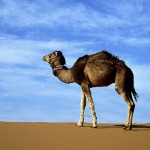 Name: Dromedary Camel Scientific Name: Camelus Dromedarius Commonly known as: One humped Camel Type Locality: Deserts of Libya and Arabia, Africa General Characteristics: Body Length: 280– 300 cm Shoulder Height: 200 – 210 cm Tail Length: 50 cm Weight: 1350 – 2200 lb The coat of these camels will range in the beige to light brown range. The underside of the belly will be a shade lighter than the top. Selective breeding has, in the newer times, given rise to camels than can be dark brown in color. Some of them have also been whitish in color. The legs of these animals are long and slender. You will find calluses on their knees. This is from them kneeling down or lying down. Although the dromedary is often called the one-humped camel, [...]
Name: Dromedary Camel Scientific Name: Camelus Dromedarius Commonly known as: One humped Camel Type Locality: Deserts of Libya and Arabia, Africa General Characteristics: Body Length: 280– 300 cm Shoulder Height: 200 – 210 cm Tail Length: 50 cm Weight: 1350 – 2200 lb The coat of these camels will range in the beige to light brown range. The underside of the belly will be a shade lighter than the top. Selective breeding has, in the newer times, given rise to camels than can be dark brown in color. Some of them have also been whitish in color. The legs of these animals are long and slender. You will find calluses on their knees. This is from them kneeling down or lying down. Although the dromedary is often called the one-humped camel, [...] -
The Giant Freshwater Stingray
Posted in Wildlife A-Z | August 17, 2010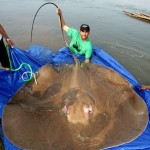 Did you know that, scientifically speaking, fish species possess what is called ‘indeterminate growth’? This would mean that they’re capable of growing as long as they continue getting food and habitat. Given the fact that they’re free from disease, they continue to grow and grow some more. This logic, and the richness of food that these fishes have been privy to based on the regions that they live in, have given rise to a number of super-sized species of fish across the world. Most of these giants will be found in tributaries of rivers that have been isolated. These end up providing for a steady amplification of the size of fishes. According to statistics, if a fish has to be called a giant fish, it must quantify these two provisions [...]
Did you know that, scientifically speaking, fish species possess what is called ‘indeterminate growth’? This would mean that they’re capable of growing as long as they continue getting food and habitat. Given the fact that they’re free from disease, they continue to grow and grow some more. This logic, and the richness of food that these fishes have been privy to based on the regions that they live in, have given rise to a number of super-sized species of fish across the world. Most of these giants will be found in tributaries of rivers that have been isolated. These end up providing for a steady amplification of the size of fishes. According to statistics, if a fish has to be called a giant fish, it must quantify these two provisions [...] -
Prehistoric Underwater Terrors That Continue To Lurk Around
Posted in Wildlife A-Z | August 5, 2010 Have you noticed something? Most of the prehistoric creatures that walked earth had something terror-like about them. They all seemed monstrous in their own rights. Fortunately for us, most of them didn’t survive the test of time; and were made extinct long before we began to wander the likes of earth; and this is good news for sure. Is it? Maybe it’s not! Maybe you’re only safe until you stay on land. If recent photos and studies are to be believed; some of the ugly monstrosities of the prehistoric times continue to rule the underwater domain till date. ‘Brrrrrrrrrrrr’, I say! I doubt you’d want to come face to face with any of these ugly creatures. The Goblin Shark Like sharks weren’t terrifying enough, God had to design a [...]
Have you noticed something? Most of the prehistoric creatures that walked earth had something terror-like about them. They all seemed monstrous in their own rights. Fortunately for us, most of them didn’t survive the test of time; and were made extinct long before we began to wander the likes of earth; and this is good news for sure. Is it? Maybe it’s not! Maybe you’re only safe until you stay on land. If recent photos and studies are to be believed; some of the ugly monstrosities of the prehistoric times continue to rule the underwater domain till date. ‘Brrrrrrrrrrrr’, I say! I doubt you’d want to come face to face with any of these ugly creatures. The Goblin Shark Like sharks weren’t terrifying enough, God had to design a [...] -
Arctic hare – residing in tundra region of North America
Posted in Wildlife A-Z | July 15, 2010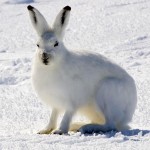 The arctic hare resides within the harsh setting of the tundra region in North America. These artic hares by no means hibernate; on the other hand live on the dangerous cold with several behavioral as well as physiological adaptations. The arctic hare sport thick fur as well as enjoy the low surface region to volume ratio, which conserves the heat of the body, most apparent in their reduced ears. These artic hares from time to time dig shelters for them in snow as well as huddle together for sharing the warmth of their body. Artic hares are slightly larger, when compared with the regular rabbits, as well as they usually have taller posterior legs along with longer ears. Similar to various other rabbits and hares, Arctic hares are speedy as well [...]
The arctic hare resides within the harsh setting of the tundra region in North America. These artic hares by no means hibernate; on the other hand live on the dangerous cold with several behavioral as well as physiological adaptations. The arctic hare sport thick fur as well as enjoy the low surface region to volume ratio, which conserves the heat of the body, most apparent in their reduced ears. These artic hares from time to time dig shelters for them in snow as well as huddle together for sharing the warmth of their body. Artic hares are slightly larger, when compared with the regular rabbits, as well as they usually have taller posterior legs along with longer ears. Similar to various other rabbits and hares, Arctic hares are speedy as well [...] -
Beluga aka White whale
Posted in Wildlife A-Z | July 1, 2010 Belugas are commonly known as white whales. The usual color of Belugas makes them one of the few most familiar and can be easily distinguished amongst other whale species. Calves are born gray or even brown and only fade to white as they become sexually mature around five years of age. White whales are quite small in size. They range from 13 feet to 20 feet (around 4 meters to 6.1 meters) in their length. White whales have little curve on the forehead and do not have a dorsal fin. Belugas normally live together within small groups, which are known as pods. White whales are social animals and are extremely vocal communicators and make diversified sounds using whistles, clangs, and clicks. Belugas are also capable of mimicking several other [...]
Belugas are commonly known as white whales. The usual color of Belugas makes them one of the few most familiar and can be easily distinguished amongst other whale species. Calves are born gray or even brown and only fade to white as they become sexually mature around five years of age. White whales are quite small in size. They range from 13 feet to 20 feet (around 4 meters to 6.1 meters) in their length. White whales have little curve on the forehead and do not have a dorsal fin. Belugas normally live together within small groups, which are known as pods. White whales are social animals and are extremely vocal communicators and make diversified sounds using whistles, clangs, and clicks. Belugas are also capable of mimicking several other [...] -
GULF OIL SPILL AFFECTS WILDLIFE
Posted in Wildlife A-Z | June 29, 2010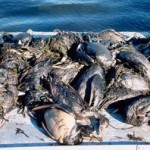 The entire world was shocked when it happened. Just happening wasn’t enough, it continued, and continued some more. When the Deepwater Horizon explosion happened on the 20th of April, 2010; little did anyone know that this would turn out to be the worst spill in the whole of American history. 2 days later, the rig began sinking and on the 27 of April, the verdict was out – nearly 5,000 barrels per day were leaking into the Gulf, and polluting the water all around. The Gulf Oil Spill Affects Wildlife For those who live along the coastline of Mexico, images of the Gulf Oil debacle will never leave their minds. Pelicans that struggle to get the oil off their bodies, the dead bodies of dolphins that get washed ashore with every new wave, [...]
The entire world was shocked when it happened. Just happening wasn’t enough, it continued, and continued some more. When the Deepwater Horizon explosion happened on the 20th of April, 2010; little did anyone know that this would turn out to be the worst spill in the whole of American history. 2 days later, the rig began sinking and on the 27 of April, the verdict was out – nearly 5,000 barrels per day were leaking into the Gulf, and polluting the water all around. The Gulf Oil Spill Affects Wildlife For those who live along the coastline of Mexico, images of the Gulf Oil debacle will never leave their minds. Pelicans that struggle to get the oil off their bodies, the dead bodies of dolphins that get washed ashore with every new wave, [...]


